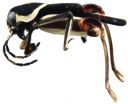(Press-News.org) When a person is experiencing a prolonged convulsive seizure, quick medical intervention is critical. With every passing minute, the seizure becomes harder to stop, and can place the patient at risk of brain damage and death. This is why paramedics are trained to administer anticonvulsive medications as soon as possible -- traditionally giving them intravenously before arriving at the hospital.
Now a major clinical trial has shown that an even faster method that involves injecting the drugs into the thigh muscle using an autoinjector (similar to a pre-loaded syringe) is just as safe and more effective.
The trial, carried out in 17 cities and 79 hospitals nationwide, involved 4,314 paramedics who treated some 893 patients ranging in age from young children to the very elderly. It took place from 2009 to 2011.
San Francisco was the third-highest enrolling city, with 121 patients. The city-wide initiative was coordinated through San Francisco General Hospital and Trauma Center (SFGH), which is part of the city's Department of Public Health. All eight emergency ambulance destination hospitals in San Francisco participated, as did the paramedics in the San Francisco Fire Department, who administered the medications in the field.
"This project is a great example of the importance of community-based emergency research and the combined strength of a city's entire health care system, when we all work together," said J. Claude Hemphill III, MD, MAS, who led the San Francisco arm of the clinical trial. Hemphill is Chief of Neurology at SFGH and co-director of the UCSF Brain & Spinal Injury Center.
The results of the trial, sponsored by the National Institutes of Health, are described this week in the New England Journal of Medicine (2/16/12).
WHY SPEED SAVES LIVES
The particular condition addressed in the study is known as status epilepticus, a seizure that lasts longer than five minutes and does not stop on its own. The episode is a potentially life-threatening emergency that is associated with 55,000 deaths each year. Prolonged status epilepticus can last for hours and sometimes is controlled only with general anesthesia.
First-line treatment for these seizures has involved administering anticonvulsant medications directly into a vein, but starting an IV line in a patient experiencing convulsive seizures can pose a challenge for paramedics and take precious time.
Giving an intramuscular shot of anticonvulsant medicine into a patient's thigh muscle is easier and faster. The motivation for the trial was to determine if it would be as safe and effective as an IV medication. The study compared how well delivery by each method stopped patients' seizures by the time the ambulance arrived at the emergency department.
Specifically, the study compared two medicines known to be effective in controlling seizures, midazolam and lorazepam. Both are benzodiazepines, a class of sedating anticonvulsant (antiseizure) drugs. Midazolam was a candidate for injection because it is rapidly absorbed from muscle. But lorazepam must be given by IV.
WHAT THE RAMPART TRIAL SHOWED
The study, formally named the Rapid Anticonvulsant Medication Prior to Arrival Trial (RAMPART) study, was the first randomized clinical trial to investigate whether intramuscular (IM) delivery of midazolam was as effective as IV lorazepam. IV medications are the current standard for acute seizure treatment. RAMPART started in June 2009 and completed enrollment in January 2011.
Paramedics involved in the trial used study boxes with a time-stamped voice recorder that allowed them to indicate the time treatment began and the time the patient's convulsions stopped, all without having to interrupt patient care to record data. The goal of the study was to stop the patient from having convulsive seizures without having to deliver a second "rescue" dose of medicine.
In RAMPART, 73 percent of patients in the group receiving IM midazolam were seizure-free upon arrival at the hospital, compared to 63 percent of patients who received IV treatment with lorazepam. Patients treated with midazolam were also less likely to require hospitalization and admission to an intensive care unit than those receiving IV lorazepam. Among those admitted, both groups had similarly low rates of recurrent seizures.
"It's much easier to give intramuscular injections than have to start an IV," said Hemphill. "Given the results of RAMPART, it is time for every emergency medical system in the United States to move toward intramuscular injection of midazolam as a first treatment to stop seizures in the prehospital setting."
In the study, paramedics used special autoinjectors that were prefilled with midazolam. The investigators said that while autoinjectors might someday be available for use by epilepsy patients and their family members, more research is required. Because of the strong sedative effect of midazolam, on-site medical supervision is now required for the safety of the patient.
Another special aspect of the study was that it was conducted under a special federal regulation known as exception from informed consent for emergency research. This exception is designed to protect patients who are involved in research when consent is not possible because of their medical condition. Community consultation is held in advance of the study to raise awareness, ensure transparency, and get input from local residents.
"This study establishes that rapid intramuscular injection of an anticonvulsant drug is safe and effective," said Walter Koroshetz, M.D., deputy director of the National Institute of Neurological Disorders and Stroke (NINDS), part of the NIH, which funded the study.
INFORMATION:
The article, "Intramuscular versus Intravenous Therapy for Prehospital Status Epilepticus" by Robert Silbergleit, Valerie Durkalski, Daniel Lowenstein, Robin Conwit, Arthur Pancioli, Yuko Palesch, and William Barsan, for the Neurological Emergencies Treatment Trials (NETT) network is published in the New England Journal of Medicine on February 16, 2012.
The Neurological Emergencies Treatment Trials (NETT) network of investigators that designed and carried out the trial was established by NINDS to conduct clinical trials on a variety of acute conditions affecting the brain such as seizures, stroke, and traumatic brain injury. NETT investigators are organized into a system of 17 major research hospitals throughout the country, each of which is linked to several community hospitals and other medical centers.
Additional funding was provided by the NIH Countermeasures Against Chemical Threats (NIH CounterACT) program and the Biomedical Advanced Research and Development Authority (BARDA). The Department of Defense's Chemical Biological Medical Systems (CBMS) Joint Project Management Office provided the autoinjectors for the trial under a Memorandum of Agreement with NINDS.
UCSF is a leading university dedicated to promoting health worldwide through advanced biomedical research, graduate-level education in the life sciences and health professions, and excellence in patient care.
Follow UCSF
UCSF.edu | Facebook.com/ucsf | Twitter.com/ucsf | YouTube.com/ucsf
Improved emergency treatment for prolonged seizures
SFGH and UCSF coordinate San Francisco-wide participation in nationwide study that finds new method safe and effective
2012-02-16
ELSE PRESS RELEASES FROM THIS DATE:
Lava formations in western US linked to rip in giant slab of Earth
2012-02-16
Like a stream of air shooting out of an airplane's broken window to relieve cabin pressure, scientists at Scripps Institution of Oceanography at UC San Diego say lava formations in eastern Oregon are the result of an outpouring of magma forced out of a breach in a massive slab of Earth. Their new mechanism explaining how such a large volume of magma was generated is published in the Feb. 16 issue of the journal Nature.
For years scientists who study the processes underlying the planet's shifting tectonic plates and how they shape the planet have debated the origins of ...
Black hole came from a shredded galaxy
2012-02-16
Astronomers using NASA's Hubble Space Telescope have found a cluster of young, blue stars encircling the first intermediate-mass black hole ever discovered. The presence of the star cluster suggests that the black hole was once at the core of a now-disintegrated dwarf galaxy. The discovery of the black hole and the star cluster has important implications for understanding the evolution of supermassive black holes and galaxies.
"For the first time, we have evidence on the environment, and thus the origin, of this middle-weight black hole," said Mathieu Servillat, who worked ...
Plasmas torn apart
2012-02-16
VIDEO:
An argon plasma jet forms a rapidly growing corkscrew, known as a kink instability. This instability causes an even faster-developing behavior called a Rayleigh-Taylor instability, in which ripples grow and...
Click here for more information.
PASADENA, Calif.—January saw the biggest solar storm since 2005, generating some of the most dazzling northern lights in recent memory.
The source of that storm—and others like it—was the sun's magnetic field, described by ...
Tool assessing how community health centers deliver 'medical home' care may be flawed
2012-02-16
On the health front, the poor often have at least two things going against them: a lack of insurance and chronic illnesses, of which diabetes is among the most common.
The federal Affordable Care Act would expand the capacity of the nation's 8,000 community health centers to provide care for low-income, largely minority patients — from the current 20 million to about 40 million by 2015. The federal government is also trying to ensure that these community health centers deliver high-quality primary care, including diabetes care.
A crucial part of this is the implementation ...
Astronomers watch delayed broadcast of a rare celestial eruption
2012-02-16
Pasadena, CA— Eta Carinae, one of the most massive stars in our Milky Way galaxy, unexpectedly increased in brightness in the 19th century. For ten years in the mid-1800s it was the second-brightest star in the sky. (Now it is not even in the top 100.) The increase in luminosity was so great that it earned the rare title of Great Eruption. New research from a team including Carnegie's Jose Prieto, now at Princeton University, has used a "light echo" technique to demonstrate that this eruption was much different than previously thought. Their work is published Feb. 16 in ...
Contraceptive preferences among young Latinos related to sexual decision-making
2012-02-16
CORVALLIS, Ore. – Half of the young adult Latino men and women responding to a survey in rural Oregon acknowledge not using regular effective contraception – despite expressing a desire to avoid pregnancy, according to a new Oregon State University study.
Researchers say the low rate of contraception among sexually active 18- to 25-year-olds needs to be addressed – and not just among Latino populations. Research has shown many young adults from all backgrounds eschew contraception for many reasons including the mistaken belief that they or their partners cannot get pregnant.
"The ...
Complexities in caregiving at the end of life
2012-02-16
Faced with the inevitability of death, we all wish for good caregiving during the final stage of our lives. A new study from Karolinska Institutet and Umeå University shows that non-pharmacological caregiving at the end of life in specialized palliative care is not as basic as one might believe but is based on complex professional decisions that weave physical, psychosocial and existential dimensions into a functional whole. The researchers have found that particularly important aspects of palliative care are an aesthetically pleasing, safe and comfortable environment, ...
New miniature grasshopper-like insect is first member of its family from Belize
2012-02-16
Scientists at the University of Illinois, USA have discovered a new species of tiny, grasshopper-like insect in the tropical rainforests of the Toledo District in southern Belize. Dr Sam Heads and Dr Steve Taylor co-authored a paper, published in the open access journal ZooKeys, documenting the discovery and naming the new species Ripipteryx mopana. The name commemorates the Mopan people – a Mayan group, native to the region.
"Belize is famous for its biodiversity, although very little is known about the insect fauna of the southern part of the country. This is particularly ...
Research highlights urgent need to tackle low number of organ donors from BME communities
2012-02-16
There is an urgent need to increase the number of organ donors from black and minority ethnic (BME) groups in countries with a strong tradition of immigration, such as the UK, USA, Canada and the Netherlands, in order to tackle inequalities in access and waiting times.
That is the key finding of a research paper on ethnicity and transplants, published by the Journal of Renal Care in a free online supplement that includes 15 studies on different aspects of diabetes and kidney disease.
"BME groups are disproportionately affected by kidney problems for a number of ...
Green spaces reduce stress levels of jobless, study shows
2012-02-16
Stress levels of unemployed people are linked more to their surroundings than their age, gender, disposable income, and degree of deprivation, a study shows.
The presence of parks and woodland in economically deprived areas may help people cope better with job losses, post traumatic stress disorder, chronic fatigue and anxiety, researchers say.
They found that people's stress levels are directly related to the amount of green space in their area – the more green space, the less stressed a person is likely to be.
Researchers measured stress by taking saliva samples ...
LAST 30 PRESS RELEASES:
Jeonbuk National University study shows positive parenting can protect adolescents against self-harm
Surface-engineered ZnO nanocrystals to tackle perfluoroalkyl substance contamination
This new understanding of T cell receptors may improve cancer immunotherapies
A new fossil face sheds light on early migrations of ancient human ancestor
A new immunotherapy approach could work for many types of cancer
A new way to diagnose deadly lung infections and save lives
40 percent of MRI signals do not correspond to actual brain activity
How brain-inspired algorithms could drive down AI energy costs
Gum disease may be linked to plaque buildup in arteries, higher risk of major CVD events
Contrails are a major driver of aviation’s climate impact
Structure of dopamine-releasing neurons relates to the type of circuits they form for smell-processing
Reducing social isolation protects the brain in later life
Keeping the heart healthy increases longevity even after cancer
Young adults commonly mix cannabis with nicotine and tobacco
Comprehensive review illuminates tau protein's dual nature in brain health, disease, and emerging psychiatric connections
Book prepares K-12 leaders for the next public health crisis
Storms in the Southern Ocean mitigates global warming
Seals on the move: Research reveals key data for offshore development and international ecology
Sports injuries sustained during your period might be more severe
World's first successful 2 Tbit/s free-space optical communication using small optical terminals mountable on satellites and HAPS
Can intimate relationships affect your heart? New study says ‘yes’
Scalable and healable gradient textiles for multi‑scenario radiative cooling via bicomponent blow spinning
Research shows informed traders never let a good climate crisis go to waste
Intelligent XGBoost framework enhances asphalt pavement skid resistance assessment
Dual-function biomaterials for postoperative osteosarcoma: Tumor suppression and bone regeneration
New framework reveals where transport emissions concentrate in Singapore
NTP-enhanced lattice oxygen activation in Ce-Co catalysts for low-temperature soot combustion
Synergistic interface engineering in Cu-Zn-Ce catalysts for efficient CO2 hydrogenation to methanol
COVID-19 leaves a lasting mark on the human brain
Scientists use ultrasound to soften and treat cancer tumors without damaging healthy tissue
[Press-News.org] Improved emergency treatment for prolonged seizuresSFGH and UCSF coordinate San Francisco-wide participation in nationwide study that finds new method safe and effective



